Step by step through a simple print
(a 'photo sequence' showing the making of a print for the [Baren Exchange #2])

Design: 8:30 AM ~ : The first step is of course to create the design. This print is very simple, and was easily sketched in a few minutes, with a drafting pen on plain white paper.
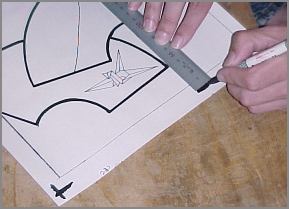
Registration marks: 8:40 AM: Once the 'sen-gaki' (outline drawing) is ready, the location of the registration marks is carefully drawn in. They appear here at the bottom of the drawing, with the corner mark at the left side - this orientation will be reversed when the hanshita (the block copy) is pasted face-down on the woodblock later.
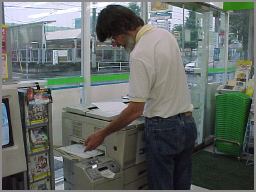
Preparing the 'hanshita' (the block copy): 8:45 AM: It would be possible to simply paste this sheet of paper face down on the block and start carving, but I much prefer using a thin Japanese paper. So it's over to the local convenience store to make a photocopy ... onto a special paper that I have prepared myself. This is a lamination - an extremely thin 'gampi' paper (which of course won't go through the copy machine by itself) bonded to a sheet of normal copy paper with a spray glue.
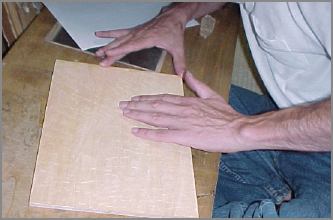
Pasting the hanshita: Back from the copy shop, and ready to paste the copied hanshita down. After first checking the surface of the wood for imperfections, I spread some sticky glue over the surface and spread it out.
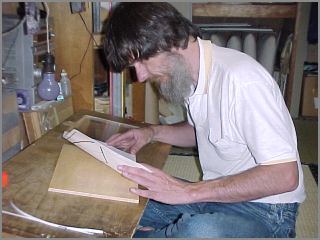
Pasting the hanshita: Down goes the hanshita (face down) , still attached to its backing sheet.
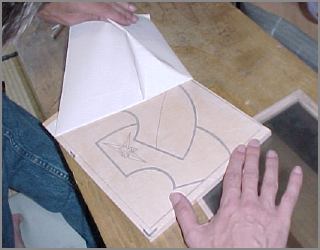
Pasting the hanshita: Once the paper is firmly stuck to the wood, pull off the backing sheet, being careful not to disturb the hanshita in any place. Note that the design is clearly visible through the thin paper, and that the corner registration mark now appears in the right-hand corner.
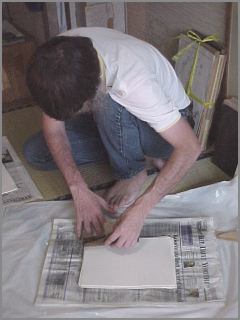
Paper preparation: 9:00 AM: With all the preparation for carving now done, it's time to look ahead a little bit, and start preparing the paper for the printing. For this print I will use a 'hosho' paper made by Mr. Kazuo Yamaguchi of Fukui Prefecture. The exchange print needs an edition of 30, so I cut 40 sheets to the proper size, and moisten them. My 'mizubake' (water brush) isn't very visible in this photo, but I am brushing quite a lot of water over the sheets ... every second one. I also moisten a number of folded sheets of newsprint, stack the whole batch together, and slip it into a large plastic bag where the moisture will even out over the coming few hours.
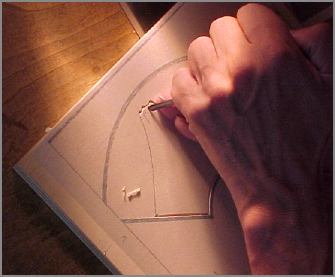
Key block carving: 10:00 AM ~ The carving begins. A key block like this will be carved with four tools (shown in this and the next three photos ...)
Stage one - cutting the lines with the 'hangito', the carving knife. Simply going over the entire image; incising both sides of each line ...

Key block carving ... continued: Stage two - once all the lines have been cut, the 'marunomi' (shallow round chisel) is used to clear away waste wood in the interior spaces of the design, and to cut a trench around the cut lines.

Key block carving ... continued: Stage three - the marunomi could not be brought right up to the lines, so the small flat chisels known as 'aisuki' are used to clear away waste wood along the lines.
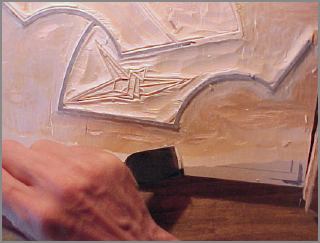
Key block carving ... continued: Stage four - the broad 'soainomi' clearing chisel is used to clear away wide areas of unneeded wood around the edge of the design. When I was a less- experienced printmaker, I used smaller chisels for this job, wasting incredible amounts of time. This 27mm wide tool really sends the chips flying though, and the clearing job now takes only a few minutes per block. This chisel is also useful for leaving a relatively flat surface on the carved areas of wood - this helps avoid pigment build-up later during printing.
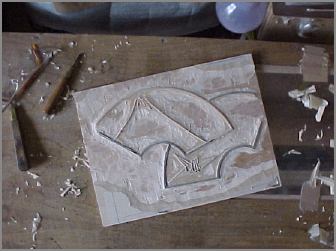
Finished key block: 11:16 AM Here is the finished key block. Note how the wood has been carved away to a distance of about 3~4cm around the design areas.
Time for lunch!

Making colour separations: 12:05 PM Back from lunch ... and the next step is to prepare the sheets (the 'kyogo') that will guide the colour carving. The paper you see being printed here is not the paper that you saw being prepared earlier. This paper is being printed in a dry state. Note also that the paper is not: being inserted into the registration marks, but is being laid on top of them. This ensures that the marks will be printed: onto these sheets; they can then be carved on the colour blocks in the correct position.
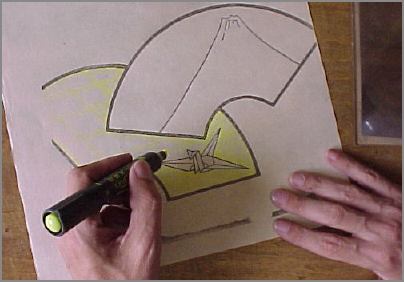
Making colour separations .. continued: I print as many kyogo as I expect there to be blocks needed for the print ... plus a couple of extra. Now the work of deciding which 'areas' will need blocks begins. Using a fluorescent marker, I mark out the 'zones' of colour. The sheet I am working on in this photo will be for the colour block used to print the background colour of the fan with the bird design.
Note that the yellow I am using has no relation at all to the colours that will appear in the finished print. It is simply an 'easy-to-see' bright tone.
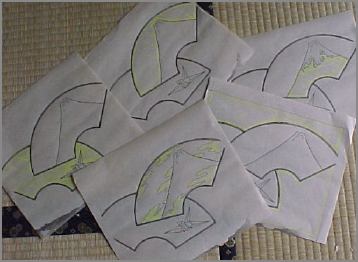
Making colour separations .. continued: Here are the kyogo for this print - five of them. There will actually be more than five colours in this print, but we'll explain that later ...
Note also that I have sketched new design elements on a couple of these sheets. These areas of colour will thus appear without a black outline around them ...

Colour separations .. continued: The kyogo are pasted down in just the same way as the original hanshita. The job is a little more critical though, because any distortion in these sheets will mean that the resulting colour blocks will not register properly with the key block.
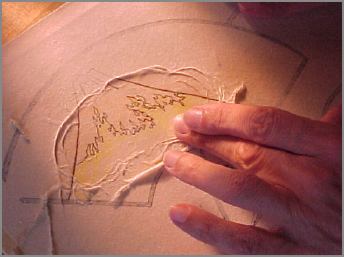
Colour separations ... continued: Because these sheets must be pasted down with no distortion, I have used a slightly heavier grade of paper than for the original hanshita, and the design is thus not clearly visible. But a few minutes work with a moistened finger will pull away fibres from the back of the paper, making it easily seen. Rubbing too hard will of course pull the paper away from the wood ...
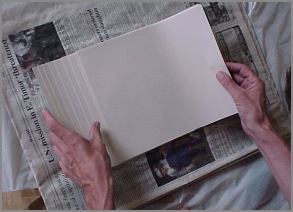
Paper preparation ... continued: Before starting the colour carving, there is one more job that has to be done with the printing paper. Now that it has been 'soaking' for a couple of hours, the package is opened up, and the sheets of paper 'crawled', as in the photo above. This is to allow each sheet to fully expand under the influence of the moisture now present inside it. I also take this chance to set the paper up in groups of ten sheets, separated by newsprint, all facing 'down' with the kento corner on the same side, so that when I start printing the paper will be all in the right orientation. I then repack it all in the plastic bag, to wait for the colour carving to be finished.

Colour carving: 12:55 ~ 3:40 Carving each colour block follows pretty much the same pattern as the key block. One difference of course is that there are no thin lines on these blocks, so the work with the 'hangito' is a simple matter of cutting around the outline of each colour mass. The other clearing work is the same ...
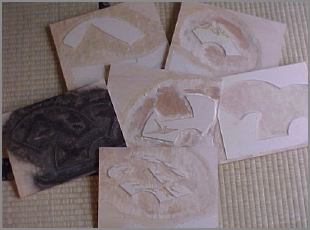
Carved blocks: 3:40 PM - Here is the finished set of blocks for this print - one key block and five colour blocks. And now, if the paper is in good condition, it's time to get started with the printing!
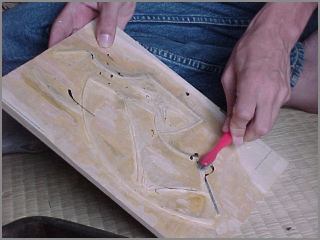
Washing the block: Here's a photo I forgot to include earlier - washing off each block after the carving is finished. One day I'll break down and get myself a bit of a larger brush for this job ...
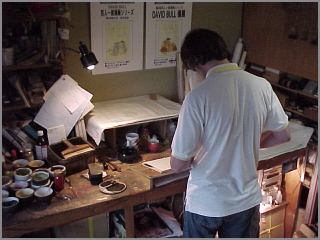
Printing ...: 4:05 PM I've started printing the key block. I do most of my regular printing sitting down in the traditional Japanese way, but because this print run is so short, I'm doing it standing up at my bench. When there are only 40 sheets, you spend more time fooling around mixing colours and changing brushes, etc., than you do actually printing, so doing it this way saves a lot of getting up and sitting down ...
The moistened paper is sitting on that small platform in front of me, covered with a plastic sheet to keep it damp. The block is directly in front of me, lying on a small tilted platform, and the printed sheets are being stacked up just over to the right.
The baren and brush are visible just to my left, and in the space under the paper stand are the bowl of black pigment, the little red bowl of paste ... and my cup of tea ...
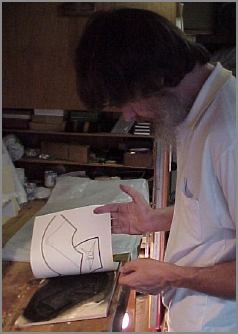
Printing ...: Here's one of the sheets coming up off the block. Note the angle of that little printing stand that sits on the main bench. It matches exactly the angle of my forearm as I press the baren onto the back of the paper ...

Printing ...: 4:40 PM, and time for the first colour block. Looking at this photo you may be somewhat confused by just what colour is being printed here ... grey?
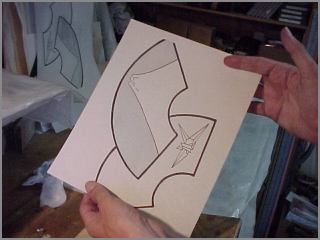
Printing ...: No, it's a light blue. But sometimes the pigment used is so dilute, that when being rubbed over the block, it simply doesn't show up against the colour of the wood.
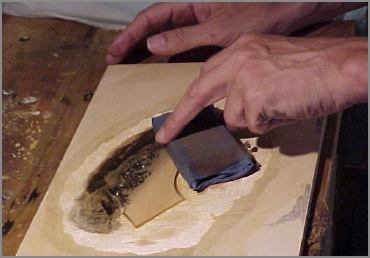
Printing ...: 5:25 PM, and the first 'bokashi' (gradation printing). The block is wiped with this wet cloth wrapped around a little block of wood. Then a dab of pigment is placed up in the area at the top of the block, a dab of paste in the clear area below it, and the brush is then used in a back and forth motion to blend them together ...

Printing ...: The result is an area of colour strong at the top, fading off to nothing at the bottom. Note that the white peak of the mountain which has thus appeared, is not printed at all - white areas of traditional Japanese prints are nearly always simply 'left over' areas of unprinted paper.
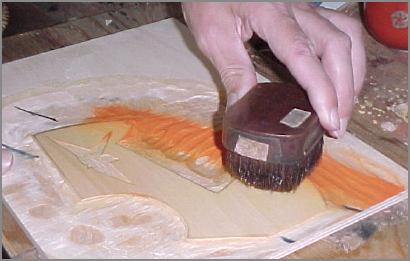
Printing ...: 6:20 PM, and another gradation. This is the block for the background behind the bird design, and it will be used twice - one gradation down from the top, and one up from the bottom. Here's the first one going on.
Note the lines drawn on the block to help me stay in the same orientation each time ... The brush is being moved back and forth exactly along that line. Pigment is only present in the 'back' end of the brush - at the front is only paste ...
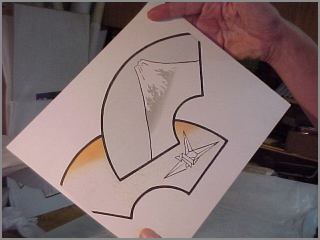
Printing ...: Here is the resulting gradation ...

Printing ...: 7:10 PM The lower half of the area is done in the same way ... The two gradations (orange and green) could actually be done at the same time, using one long brush with colour dabbed on each end, and if this was a much longer run ... some hundreds of copies, that's the way that I would do it.
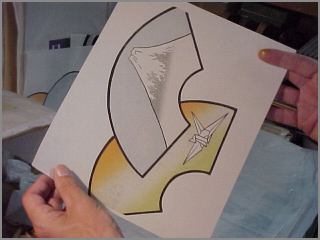
Printing ...: 7:40 PM With five colours done, we're just over half-way through the printing process. But that's enough for one day I think ...
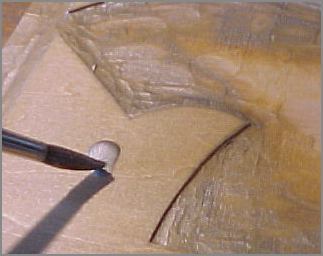
Printing ...: 9:00 AM ~ (second day). Unfortunately for this 'photo essay', my two photographers are not available this morning - they would rather go to their figure skating lesson! (These kids today ... no sense of responsibility ...)
So we've missed a bit here. The first colour of the morning was a light sandy brown, printed in the background area around the two fans. Once that was done, I then printed the same block again, but this time with a mixture of nikawa (liquid gelatine) and aluminum powder. You can see some of this mixture being dabbed onto the block in this photo (a 'one-handed' camera shot ...)
There isn't enough metal powder to totally cover the printed area with a silver colour - there is just enough to add a sparkled effect across the background of the print.
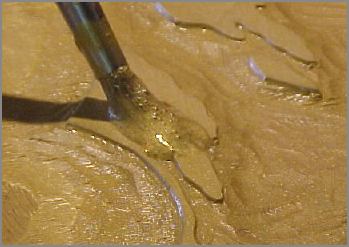
Printing ...: 10:30 AM ~ We're missing another photo here too. This is the block for the clouds that hover around the mountain, and this block is printed twice. The first impression was a flat yellow ochre tone. When it was done, I printed another metallic mixture over top of it. This time the pigment is a commercial preparation known as 'Pearl Gold'. I think it's titanium flakes, or something like that, mixed with a gelatine-like binder. Printing the pearl without a yellow base coat underneath it gives quite a weak effect, but with a good solid base in place, the gold effect is much more effective.
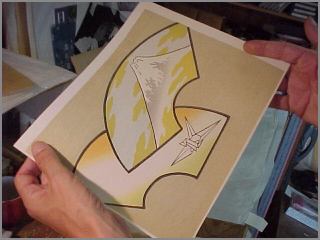
Printing finished: 12:00 noon. So here she is - the kids return just in time to take a photo of the finished print. Not the most dramatic print you'll ever see, but pretty I think ...
Six blocks ... nine impressions.
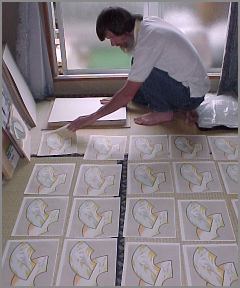
Drying: With the door cracked open just a bit, to allow some air flow through the room, I lay them out on the mats for just a few minutes, to allow most of the moisture to fly out of the paper. If I left them like this much longer, they would crinkle up ... just a few minutes is enough. I then put them one by one between sheets of flat card for the final drying. They come out a couple of hours later perfectly dry and flat.
All that remains is to trim them to size in a paper cutter (the finished print has no visible white border), check them over, sign them, and then send them off to John, the coordinator for this Exchange.
Thanks for coming this far through all these photos! I hope it's been worthwhile ... And special thanks to my two daughters for 'coming running' every time I called for another photograph!

